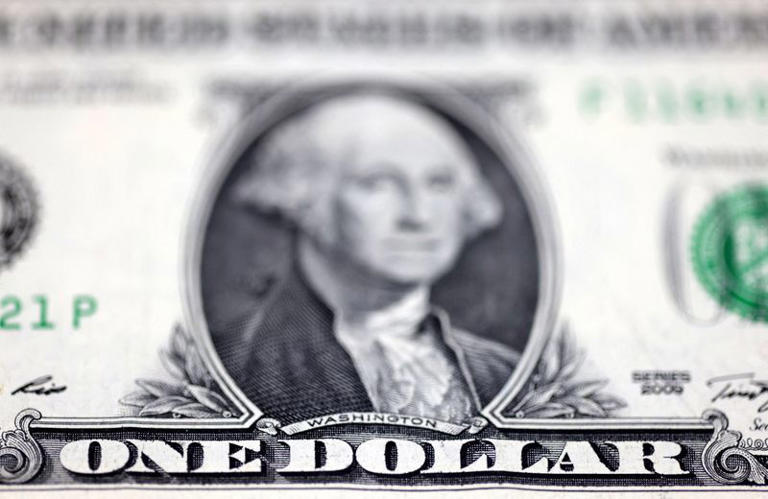The U.S. dollar is defying expectations of a decline, bolstered by a resilient American economy that has thwarted predictions of interest rate cuts. Year-to-date, the dollar index, a measure of its strength against other major currencies, has surged by 2.4%, catching investors off guard. Data from the Commodity Futures Trading Commission reveals that net bets on the dollar turned positive last month for the first time since late November.
The dollar’s unexpected resilience is primarily attributed to the robust performance of the U.S. economy, which has compelled the Federal Reserve to adopt a cautious approach towards monetary easing. Concerns about triggering inflationary pressures have prompted the Fed to refrain from implementing rate cuts hastily. In contrast to the U.S., economic growth stagnated in the eurozone last year, China grapples with a deepening property crisis, and Japan unexpectedly slipped into recession in late 2023.
Thierry Wizman, global FX and rates strategist at Macquarie, notes that while the U.S. economy remains sturdy, there are limited signs of recovery in Europe and China. This disparity in economic performance has led investors to reassess their outlook on the dollar, shifting towards a more neutral stance compared to the bearish sentiment prevalent last year.
The resilience of the dollar will face scrutiny this week as investors await testimony from Federal Reserve Chairman Jerome Powell before lawmakers on Wednesday and Thursday. Additionally, the release of U.S. employment data later in the week will provide further insight into the strength of the American economy. Continued indications that the Fed intends to maintain its current stance of “higher for longer” on rate cuts, or evidence of sustained economic strength in the U.S., could bolster the dollar’s ongoing rally.
Investors have adjusted their expectations for interest rate cuts in 2024, with futures tied to the Federal Reserve’s policy rate now pricing in around 85 basis points of cuts. This is a significant decrease from the more than 150 basis points factored in at the beginning of January.
Despite the reduced expectations for rate cuts, some investors remain bullish on the U.S. dollar. Ugo Lancioni, head of currency at Neuberger Berman, is among those betting on the greenback’s continued ascent. He acknowledges that the dollar may appear expensive relative to other currencies but believes that its strength will persist due to U.S. outperformance.
Lancioni explains that their current call is primarily based on relative growth dynamics, emphasizing the strong performance of the U.S. economy compared to other regions.
The trajectory of the dollar is of utmost importance for investors, given its central role in global finance. A strong dollar could have implications for U.S. multinational companies, affecting their ability to convert foreign profits into dollars. Additionally, it could make exporters’ products less competitive in foreign markets. FactSet data indicates that approximately a quarter of S&P 500 companies generate more than 50% of their revenues outside the U.S., highlighting the potential impact of currency fluctuations on corporate earnings.
The strength of the dollar could pose challenges for other central banks in their efforts to combat inflation, as it effectively makes their currencies cheaper. The European Central Bank, for example, has resisted talk of rate cuts due to persistent inflationary pressures. Any indications from euro zone policymakers suggesting a delay in easing measures could lead to a boost for the euro at the expense of the dollar.
Despite the dollar’s recent resilience, many strategists maintain a bearish outlook on the currency. However, the dollar’s continued strength has caused some to reassess their forecasts. According to a Reuters poll in February, while the median forecast among currency strategists is for the dollar to weaken over the rest of the year, around 80% acknowledged the risk of the dollar exceeding their targets.
Paul Mielczarski, head of macro strategy at Brandywine Global, views the recent rebound of the dollar as more of a short-term tactical rally rather than a fundamental shift in the currency’s overall trend. He points to emerging signs of improved growth outside the U.S., such as strength in the global semiconductor cycle, which can benefit currencies like the Korean won.
However, some analysts see potential catalysts for further dollar strength, particularly if former U.S. President Donald Trump gains traction in a presidential reelection race that has been closely contested for months. Analysts at Capital Economics suggest that Trump’s proposed tariff increases could prompt the Fed to adopt a tighter monetary policy stance, leading to a wider trade war and increased demand for the safe-haven U.S. currency.
While the scenario of Trump’s return to power may still be uncertain, investors are likely to remain cautious about taking bearish positions against the dollar. Thierry Wizman of Macquarie suggests that traders are adopting a “show me” attitude, indicating a high level of skepticism about the direction of the currency.
